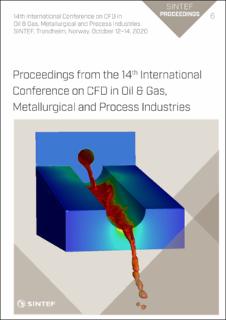| dc.contributor.author | Bublik, Sergey | |
| dc.contributor.author | Einarsrud, Kristian Etienne | |
| dc.date.accessioned | 2021-03-26T13:13:39Z | |
| dc.date.available | 2021-03-26T13:13:39Z | |
| dc.date.created | 2020-12-23T11:36:28Z | |
| dc.date.issued | 2020 | |
| dc.identifier.isbn | 978-82-536-1684-1 | |
| dc.identifier.uri | https://hdl.handle.net/11250/2735760 | |
| dc.description.abstract | The entrainment of molten ferroalloy droplets in slag during tapping operations is strongly related to turbulence and interfacial forces between alloy and slag. Therefore, interfacial phenomena are of great importance for the ferroalloys industry and a better understanding of entrainment mechanisms can reduce ferroalloy losses with slag flow. The interfacial tension plays an important role in the interaction between ferroalloy and slag due to the ability to modify droplets shape and the flow regime. However, the measurement of interfacial tension between two molten phases is challenging due to high temperatures and complex composition. In particular, surface active elements significantly influence the interfacial tension. Available methods for determining the interfacial tension are often based on using complex equipment (e.g. a furnace equipped with an X-ray camera) and tend to have significant uncertainty in measurements. In this study, a methodology for inverse modelling of interfacial tension between ferroalloys and slag was developed and investigated by combining experimental measurements, reduced order modelling and simulations in OpenFOAM. The proposed method relies upon experimental determination of the shape of single droplets, from which surface tension can be determined using numerical procedures such as elliptic fitting and the low-bond axisymmetric drop shape technique. Given relevant material properties for single phases, parameters governing the interactions between the phases, e.g. interfacial tension, can be determined by comparing parametric simulations to experiments in which interactions are present. Simulations are realized using multiphaseInterFoam for a slag droplet at rest on molten metal in an inert atmosphere. The current work describes the modelling strategy and demonstrates its applicability to recent experiments for the FeMn-slag system. The uncertainty and sensibility of the method are assessed by comparing different available simulation settings, resolution and the uncertainty in the experimental data. | en_US |
| dc.language.iso | eng | en_US |
| dc.publisher | SINTEF Academic Press | en_US |
| dc.relation.ispartof | Proceedings from the 14th International Conference on CFD in Oil & Gas, Metallurgical and Process Industries, SINTEF, Trondheim, Norway, October 12–14, 2020 | |
| dc.rights | Navngivelse 4.0 Internasjonal | * |
| dc.rights.uri | http://creativecommons.org/licenses/by/4.0/deed.no | * |
| dc.subject | CFD-beregninger | en_US |
| dc.subject | CFD | en_US |
| dc.title | Inverse modelling of interfacial tension between ferroalloy and slag using openfoam | en_US |
| dc.type | Chapter | en_US |
| dc.description.version | publishedVersion | en_US |
| dc.subject.nsi | VDP::Metallurgi: 521 | en_US |
| dc.subject.nsi | VDP::Metallurgy: 521 | en_US |
| dc.source.pagenumber | 28-38 | en_US |
| dc.identifier.cristin | 1863049 | |
| dc.relation.project | Norges forskningsråd: 267621 | en_US |
| cristin.ispublished | true | |
| cristin.fulltext | original | |
| cristin.fulltext | original | |

